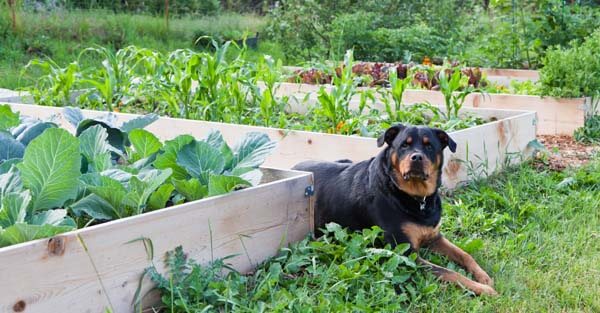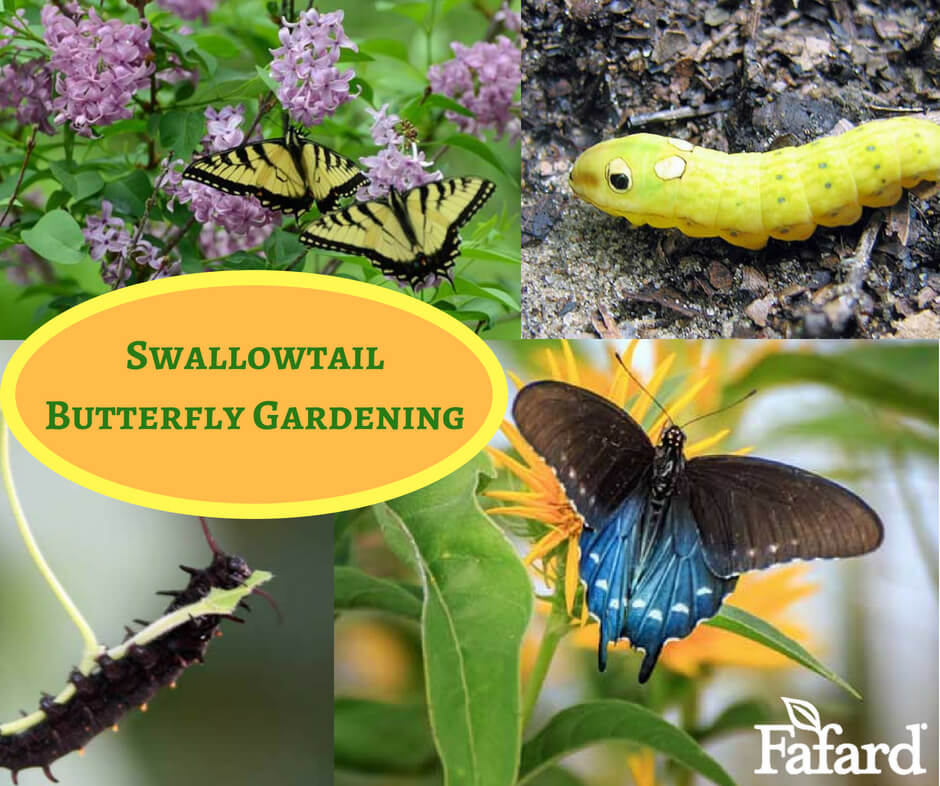
Gardeners tend to have a thing for swallowtail butterflies. Likewise, swallowtails tend to have a thing for certain plants – and certain gardens. The more you incorporate their favorites into your garden, the more they will favor you with their flighty visits.
Adult swallowtails of all species (including the half-dozen or so species native to eastern North America) share similar tastes in nectar. A border brimming with coneflowers and sages and butterfly weeds and their relatives will have them all aflutter, as will a planting of shrubby favorites such as rhododendrons and buddleias. Swallowtail caterpillars, on the other hand, are much fussier eaters, with each species following a specialized diet restricted to a narrow menu of plants. As a result, swallowtails are particularly keen on gardens that include their favorite larval foods.
Most swallowtail caterpillars confine their munching to species from one or two plant families. Some swallowtail species thrive on both introduced and indigenous plants, whereas others require natives-only fare to thrive. Know their preferred larval food sources, and you’ll know what to plant in your yard to transform it into a swallowtail haven. You’ll also know which plants to examine for the large colorful caterpillars, which in their early stages resemble animated bird droppings. Some leaf damage may also be noticeable, but it’s a modest price to pay to become the neighborhood’s most desirable swallowtail destination.
Swallowtail Caterpillar Host Plants
1. Easter Tiger Swallowtail
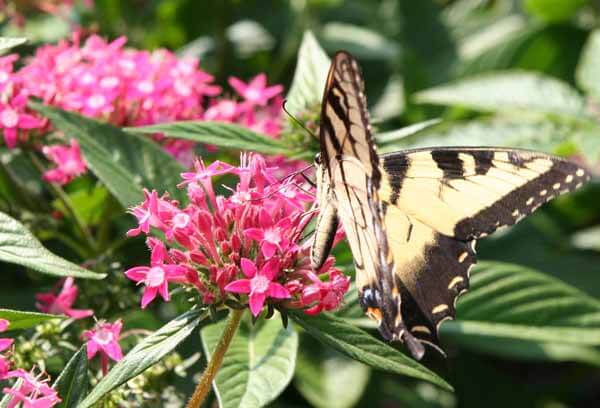
Many native and exotic trees and shrubs from the olive, rose, laurel, birch, and magnolia families host the large green caterpillars of tiger swallowtail, which sport two prominent eye-spots. Before pupating, the caterpillars turn from green to brown. Tulip tree (Liriodendron tulipifera), lilacs (Syringa spp.), river birch (Betula nigra), and sassafras (Sassafras albidum) are among the outstanding ornamental plants on the menu, as are:

Sweet bay magnolia (Magnolia virginiana). Native to eastern North America, this small, elegant, gray-barked tree has glossy-green, deciduous or evergreen leaves with silvery undersides. Scatterings of cupped, sweet-scented white flowers sporadically appear from late spring through summer.
Fringe tree (Chionanthus virginicus). Clouds of fragrant, fleecy white flowers veil the spreading branches of this large shrub or small tree in late spring. Conspicuous blue fruits ripen in late summer on some plants (particularly if a pollenizing companion fringetree is nearby).
2. Eastern Black Swallowtail
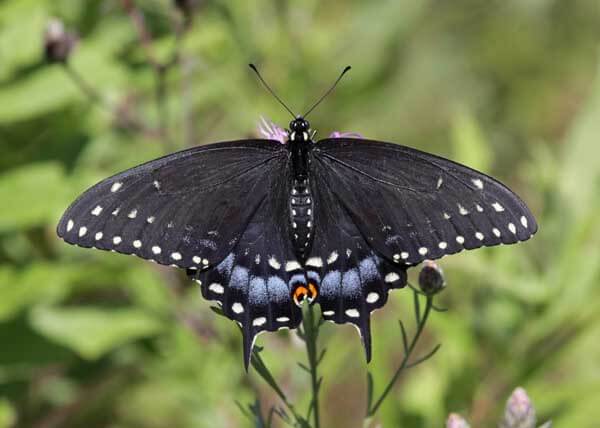
Showy, yellow-and-black-banded caterpillars feed almost exclusively on plants from the parsley family, including dill (Anethum graveolens), parsley (Petroselinum crispum), carrot (Daucus carota ssp. sativus), and fennel (Foeniculum vulgare). Bronze-leaved forms of fennel are especially effective ornamentals, their dark, filigreed leaves making a smoky contrast to bright-flowered annuals and perennials.
Also outstanding for foliage effect are the various species of Peucedanum such as giant milk parsley (Peucedanum verticillare). This short-lived perennial forms large lush hummocks of deeply divided foliage, which give rise to towering, purple-stemmed sprays of lacy white flower clusters. Most Peucedanum expire soon after flowering, but they usually self-sow (so be sure to leave some seed heads!).
3. Spicebush Swallowtail
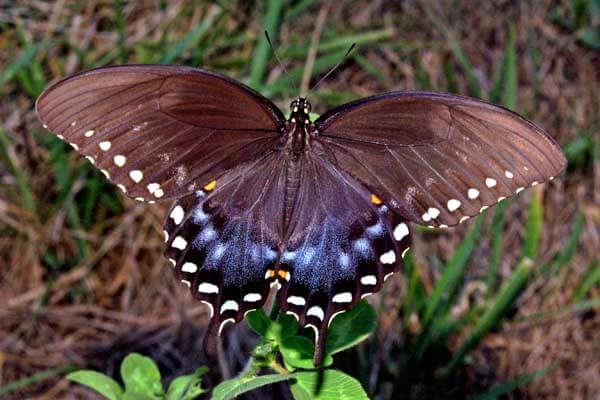
A dark-hued butterfly that somewhat resembles black swallowtail, spicebush swallowtail is one of several reasons to grow the shrub after which it’s named. So, too, are the boldly eye-spotted, green to orange-yellow larvae that browse spicebush’s fruity-scented foliage in summer. One of the earliest-blooming native plants, spicebush (Lindera benzoin) decks its branches with tufts of acid-yellow flowers

in late winter and early spring, before the leaves emerge. Bright red fruits and brilliant yellow fall foliage bring the growing season to a colorful close. Spicebush swallowtail’s other favorite host is sassafras – the only eastern North American representative of the laurel family (Lauraceae) other than Lindera benzoin.
4. Pipevine Swallowtail


If outlandish black caterpillars with orange spikes and centipede-like “legs” appear on your Dutchman’s pipe vine (Aristolochia spp.), you have the honor of a visit from this singular swallowtail species. With luck, you’ll also witness the adults, whose blue, iridescent wings are among the showiest in the butterfly tribe. The larvae thrive only on North American species of Aristolochia, dwindling away if raised on exotic Dutchman’s pipes such as Aristolochia elegans.
Two twining North American natives – Aristolochia macrophylla and A. tomentosa –make excellent climbers for locations where their wide-ranging roots have room to spread (both are hardy from USDA zones 5 to 9). Their rapidly ascending stems with heart-shaped leaves emerge from the ground in spring and lengthen to 20 or 30 feet within a few weeks. Curious, contorted, tubular flowers with flared tips appear in the leaf axils in early summer. Most other North American Aristolochia species are lower-growing perennials that spread underground to form large clumps. Virginia snakeroot (Aristolochia serpentaria) functions nicely as a deciduous ground cover for informal garden areas in sun to light shade.
5. Eastern Giant Swallowtail

Native or exotic species from the citrus and rue family (Rutaceae) entice this enormous, black, yellow-banded butterfly, whose wingspan can reach 6 inches. Gardens that are too cold for the likes of lemons (Citrus limon) and oranges (Citrus aurantiaca) can opt instead for one of the several cold-hardy Rutaceae species that host the blotchy, black and white larvae. These include hop tree (Ptelea trifoliata), a medium to large shrub from central and eastern North America with handsome, three-parted leaves and small, fragrant, late-spring flowers. Rounded, wafer-like fruits develop in late summer.

Its cultivar ‘Aurea’ – with glossy, chartreuse-yellow leaves – is one of the most striking foliage plants for temperate gardens. Swallowtail hosts for the perennial border include gas plant (Dictamnus albus), which bears showy spires of white or purple flowers in late spring on bushy, 3-foot-tall mounds of leathery, rich green foliage. Native to Eurasia, it lives to 50 years or more in gardens. Warning: contact with plants in the rue family can trigger severe dermatitis in susceptible individuals, although such cases are rare.
[Click here to get great butterfly garden designs!]




